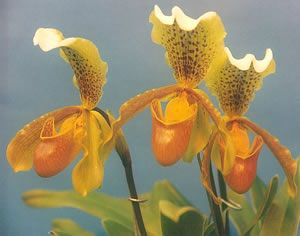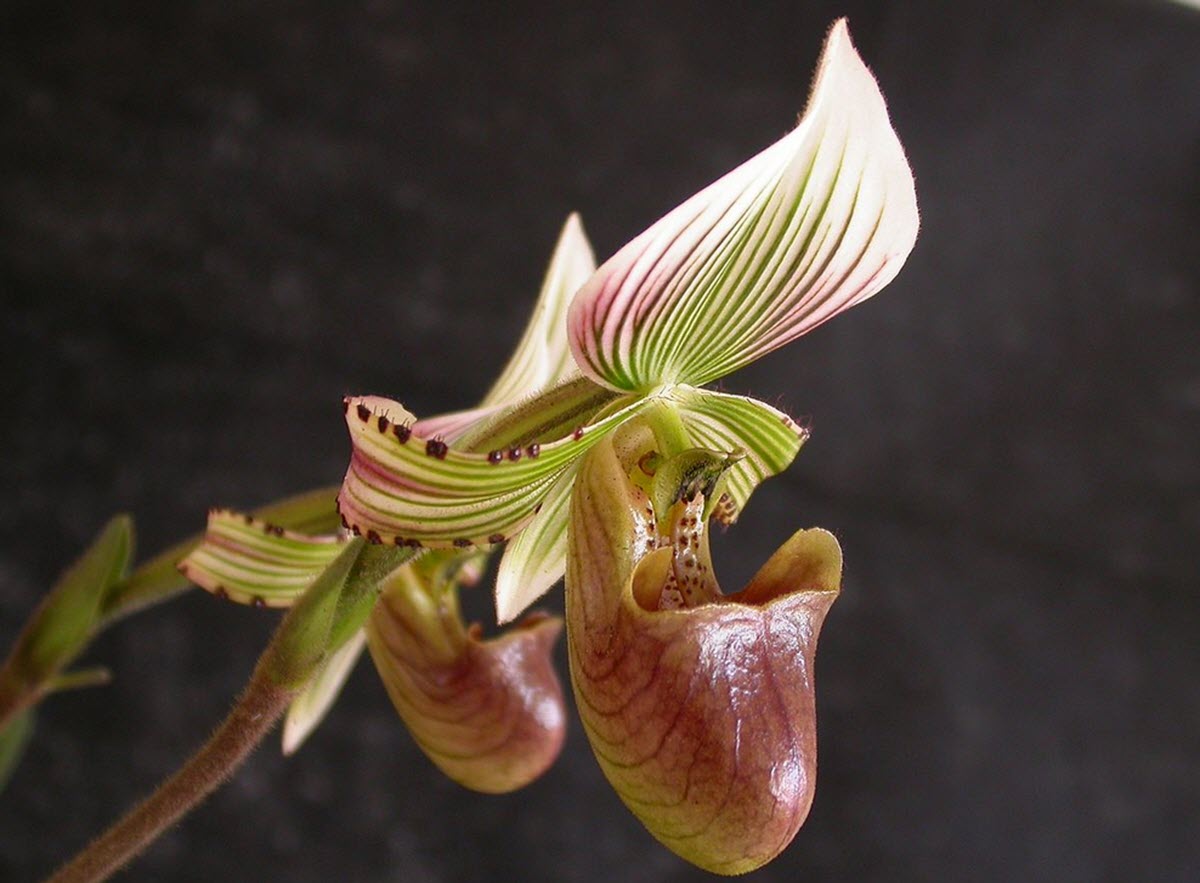Paphiopedilum Orchid Care
Contents
Paphiopedilum orchids grow wild in India, southern China, Southeast Asia and the Pacific Islands. They appreciate an environment where the humidity stays in the 50-60% range and is therefore often successfully grown in kitchens and bathrooms. If you want to place your Paphiopedilum orchid somewhere else in your home or office, you can use a humidity tray to increase air humidity around the plant.
Paphiopedilum orchids can often look almost unreal due to the lacquered or waxy surface of the flowers and their many intricate shapes and vivid colours. With the proper Paphiopedilum orchid care the bloom can last for months. This has made the Paphiopedilum orchids very popular as house plants and patio decorations.

Paphiopedilum insigne orchid
Watering
Unlike many other orchids, Paphiopedilums should never have their medium dry out completely between waterings. A few Paphiopedilums species are epiphytes and lithophytes (growing on trees or rocks, respectively), but the majority grows directly on the ground in the humus layers of the forest floor. The medium should therefore be kept moist, but never soggy. The temperature and air humidity will effect how often and how much you need to water your Paphiopedilum orchids. In a hot and dray environment, proper Paphiopedilum orchid care can involve water the plant as often as every 4th day. In cooler environments – especially if they are damp as well – you may have to water your Paphiopedilum orchid less than once a week. Always water your Paphiopedilum orchids early in the day to give the leaves a chance to dry off before sunset.
Nutrients
During the growing season a 20-20-20 fertilizer is recommended. 1-2 teaspoons of fertilizer divided into several servings is the preferred amount. Giving your Paphiopedilum orchid one single serving each month is not recommended; it is much better to divide the dose. Leach the medium thoroughly between each serving to prevent salt accumulation. (Salt accumulation can burn the root tips.) During the winter season when the temperature drops and the days become shorter, the fertilization frequency and rate should be reduced. If you live in the northern hemisphere, this resting period begins around November and ends in March for the orchid.
Temperature
When it comes to temperature, the recommended Paphiopedilum orchid care depends on which type of Paphiopedilum orchid you have. Paphiopedilum orchids can be divided into two broad categories: Maudiae type orchids and Bulldog type orchids. Maudiae type orchids prefer daytime temperatures in the 70-85°F (24-29° C) range. During the night, the temperature should ideally be decreased down to 60-65°F (15.5-18°C). Maudiae type orchids can be recognized on their mottled leaves, which separate them from the Bulldog type orchids since Bulldog orchids have uniformly green leaves. Bulldog orchids like cooler temperatures and the daytime temperature should never exceed 80°F (26.5°C). During the nights, the temperature should ideally be lowered down to 50-60°F (10-15.5°C). Bulldog orchids will only flower when provided with night time temperatures under 60°F (15.5°C) for a at least few weeks during late fall and winter. Making the nights cool enough is therefore an essential part of Paphiopedilum orchid care if you keep this type of Paphiopedilum orchids.

Paphiopedilum hennisianum: Picture by Dalton Holland Baptista
Light
Since a majority of the Paphiopedilum orchids grove on the forest floor whey they are shadowed by the canopy, these orchids are used to very low light levels. Moderate lighting is ideal for both growth and blossom production. Ideally place your Paphiopedilum orchids in an east window, or a south window with shade. West windows are not recommended since they tend to become too hot during the warm season. The exact recommendations naturally depend on which part of the world you live in; check with your local florist for more detailed info.
Potting medium
Paphiopedilum orchids should never have their medium dry out completely between waterings, but this doesn’t mean that you should plant them in a soggy medium with poor draining capability. Fine orchid bark mix is recommended for Paphiopedilum orchids.
Repotting a Paphiopedilum orchid
Paphiopedilum orchids appreciated being potted in the smallest pot possible and repoted once a year. The period right after flowering is best for repotting this type of orchids.
Paphiopedilum orchid trivia!
The name Paphiopedilum is derived from two Greek words: Paphos and pedilon. Pedilon means slipper while Paphos is the name of a city on Cyprus. The greek word for slipper in the genus name alludes to the pouch (labellum) of these orchids which is shaped a bit like the toe of a slipper. In English, Paphiopedilum orchids are commonly referred to as Lady Slippers or Lady Slipper orchids. (They are also known as “Phaphs”.) Paphiopedilum orchids are not the only orchids that goes under the name Lady’s or Venus’ Slipper Orchids; all the members of the subfamily Cypripedioideae have this slipper shaped the labellum. The “slipper” serves to trap insects that will collect or deposit pollen as they climb up from the flower.